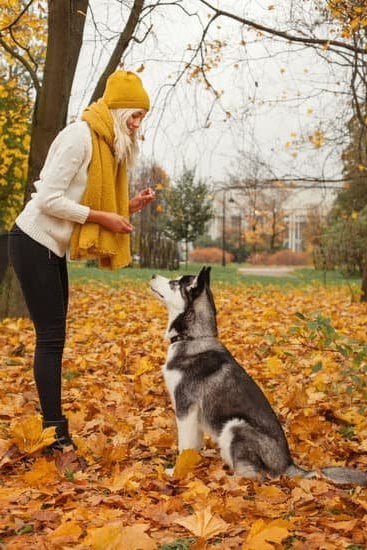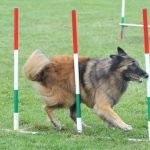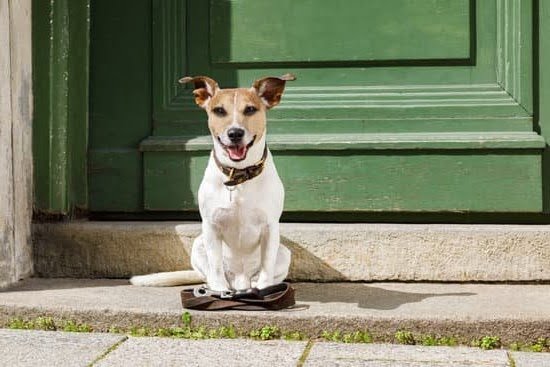Training your dog to be gentle is crucial for their well-being and the safety of those around them. Dogs who are not trained to be gentle can unintentionally cause harm or create uncomfortable situations, leading to stress and frustration for both you and your pet. By teaching your dog how to be gentle, you are promoting positive behavior and maintaining a harmonious relationship with them.
A key aspect of training your dog to be gentle is understanding the importance of positive reinforcement. Positive reinforcement utilizes rewards, such as treats or praise, to encourage desired behavior. This method focuses on rewarding good behavior rather than punishing bad behavior, creating a more enjoyable and effective training experience for both owner and dog.
To establish a solid foundation for training your dog to be gentle, it is essential to build trust and a strong bond with them. Trust is the basis of any successful relationship, including the one between you and your furry friend. By consistently providing love, attention, and clear communication during training sessions, you will develop a deep connection that allows for effective learning.
In the next sections of this article, we will explore specific techniques and exercises to guide you through each step of training your dog to be gentle. From teaching basic commands like “sit,” “stay,” and “leave it,” to addressing common behavioral issues such as jumping or excessive roughness when greeting others, each topic aims to equip you with practical methods for achieving gentleness in your furry companion.
Remember that training takes time and patience. Consistency is key when teaching your dog any new skill. With dedication and the right approach, you can successfully train your dog to be gentle, leading to a happier and healthier life together. So let’s dive into this training journey and help transform your canine companion into a model of gentility.
Understanding the importance of positive reinforcement in dog training
Positive reinforcement is a key component in training dogs to be gentle. This method of training focuses on rewarding desired behaviors with treats, praise, or affection, rather than punishing undesirable behaviors. By using positive reinforcement, you can create a positive association with good behavior, making it more likely that your dog will repeat those actions in the future.
The benefits of positive reinforcement
One of the main benefits of positive reinforcement is that it creates a strong bond between you and your dog. When your dog learns that good behavior results in rewards and praise from you, they will be motivated to listen and obey your commands. This creates trust and mutual respect, setting the foundation for a gentler relationship.
Another advantage of positive reinforcement is that it helps to build confidence in your dog. Through consistent rewards for their good behavior, they will become more confident in themselves and their abilities. This can lead to better self-control and overall gentleness when interacting with people and other animals.
Using positive reinforcement effectively
To use positive reinforcement effectively, timing is crucial. It’s important to reward your dog immediately after they exhibit the desired behavior so they can make the connection between their action and the reward. Using verbal cues such as “good boy” or “good girl” along with treats or affection can reinforce this connection even further.
Consistency is also essential when using positive reinforcement. Make sure everyone in your household is on board with the training methods to avoid confusion for your dog. It’s important to establish clear expectations and be consistent in rewarding good behavior while ignoring or redirecting unwanted behavior.
In addition to treats and praise, you can also use other forms of positive reinforcement such as playtime or access to toys as rewards. Experiment with different types of rewards to find out what motivates your dog the most.
By understanding the importance of positive reinforcement in training your dog to be gentle, you can create a bonding experience that will lay the foundation for a well-behaved and gentle companion.
Setting the foundation
Building a strong foundation of trust and a deep bond with your dog is crucial when training them to be gentle. Trust is the cornerstone of any successful relationship, and this holds true for the relationship between you and your furry friend. By earning their trust, you create an environment where they feel safe and secure, making it easier for them to learn and understand what is expected of them.
Positive Reinforcement: The Key to Success
One of the most effective ways to establish trust and encourage gentle behavior in your dog is through positive reinforcement. This technique involves rewarding your dog for good behavior rather than punishing them for mistakes. When they display gentleness or respond appropriately to commands, provide plenty of praise, treats, or other rewards that they find motivating.
It’s important to remember that punishment can lead to fear or anxiety in dogs, which can have negative consequences on their behavior. By using positive reinforcement techniques, you not only build a stronger bond with your dog but also foster a positive learning experience for them.
Building Trust Through Consistency
Consistency is key when building trust with your pet. Dogs thrive on routine and predictability, so it’s essential to establish clear boundaries and expectations from the start. Ensure that everyone in the household is on board with these rules to avoid confusing your dog.
Set aside regular time each day for training sessions so that your dog knows when to expect interaction with you. Additionally, consistency should extend beyond training sessions; make sure to consistently reinforce good behavior throughout daily life by offering praise or rewards whenever appropriate.
By consistently providing structure and guidance while remaining patient and understanding, you will lay a solid foundation based on trust-one that will set the stage for teaching your pup how to be gentle in all aspects of their life.
Teaching your dog basic commands
Teaching your dog basic commands is an essential part of training them to be gentle. By learning these commands, your dog will understand how to behave in different situations and will be better equipped to respond appropriately. Three fundamental commands that are particularly important for teaching your dog to be gentle are sit, stay, and leave it.
Sit
The command “sit” is one of the first commands you should teach your dog. It is not only a useful command for managing their behavior but also helps establish your role as the leader and teaches them self-control.
To begin teaching your dog to sit, hold a treat close to their nose and slowly move it upwards, causing their head to follow the treat and causing their bottom to lower automatically. Once they are in a sitting position, immediately reward them with the treat and use a verbal cue such as “sit” so they begin associating the action with the command.
Stay
The “stay” command is crucial for ensuring that your dog remains in a specific position until given further instruction. This command can prevent unwanted jumping, excessive excitement when greeting people or other dogs, or running out of doors or gates without permission. Start teaching this command by having your dog sit or lie down.
Then, with an open hand facing towards them like a stop signal, say “stay” while taking a step back. If they remain still for a few seconds, reward them with praise or treats. Gradually increase the distance and duration as they become more comfortable with staying in place.
Leave It
The command “leave it” teaches your dog to immediately abandon something they show interest in that may be inappropriate or potentially harmful. This command is especially important for preventing your dog from picking up dangerous objects or eating harmful substances during walks or playtime. To teach this command, hold a treat in one hand and make a fist, saying “leave it.”
If your dog tries to sniff or paw at your hand, close your hand and wait for them to lose interest. Once they do, praise them and offer a different treat from your other hand. Gradually progress to using different items with higher value as distractions, such as toys or food on the ground, always rewarding them when they successfully leave it.
By teaching your dog these basic commands of sit, stay, and leave it, you are establishing a foundation for encouraging gentle behavior. These commands empower you to manage their actions effectively in various situations and provide them with the necessary self-control to interact politely with people and other animals. Remember that consistency and positive reinforcement are key when training your dog to be gentle and obedient to these commands.
Teaching your dog to greet others politely
One common issue that many dog owners face is their dog’s overexcitement and jumping when greeting others. This behavior can be both embarrassing and potentially dangerous if your dog accidentally knocks someone over or scratches them with their paws. Therefore, it is important to teach your dog proper etiquette when they meet new people.
To begin training your dog to greet others politely, you will need to first work on teaching them the “sit” command. This command serves as a foundation for many other desired behaviors, including polite greetings. Start by holding a treat just above your dog’s nose and slowly move it back towards their rear end.
As their head follows the treat, their rear end will naturally lower into a sitting position. Once they are in the sitting position, reward them with praise and the treat.
Next, you can practice this behavior when someone comes to your door or you encounter strangers while out for a walk. If your dog starts to jump up to greet them, immediately turn away from them and cross your arms to withhold attention until all four paws are back on the ground. Once they settle down, give them the cue to sit and reward them with treats and praise when they comply.
Consistency is key in this training process. Ensure that everyone who interacts with your dog knows the importance of not reinforcing jumping behavior by giving attention only when all four paws are on the ground. Over time, with patience and dedication, your dog will start to understand that sitting calmly earns rewards and positive attention from both you and strangers.
| Week | Behavior |
|---|---|
| 1 | Dog jumps up on strangers |
| 2 | Dog jumps, but can be redirected to sit with treats |
| 3 | Dog consistently sits when greeting strangers |
| 4 | No jumping, waits for cue to sit before approaching strangers |
By patiently working on teaching your dog proper greeting etiquette, you can prevent them from being too overwhelming or potentially harming others. Remember to always use positive reinforcement and rewards to encourage the desired behavior. With consistency and practice, your dog will become a polite greeter in no time.
Handling and grooming
One important aspect of training your dog to be gentle is teaching them to be comfortable with being touched and handled. This includes grooming, vet visits, and basic handling such as having their paws touched or ears checked.
By ensuring that your dog is relaxed and calm during these situations, you can help prevent any fear or aggression that may arise from being touched in sensitive areas. Here are some tips for teaching your dog to be comfortable with handling and grooming:
- Start with positive associations: Begin by associating touch and handling with positive experiences for your dog. Offer them treats or rewards while simultaneously touching their body gently. Gradually increase the duration and intensity of the touch as your dog becomes more comfortable.
- Slowly introduce grooming tools: Introduce grooming tools like brushes, combs, or nail clippers gradually to your dog. Start by simply allowing them to sniff the tool and reward them for showing curiosity without fear or aggression. Gradually progress to touching their body gently with the tool while rewarding calm behavior.
- Practice desensitization: Gradual desensitization is an effective technique for teaching your dog to be comfortable with specific types of touch or handling they may find uncomfortable initially. For example, if your dog doesn’t like having their paws touched, start by simply touching their paw for a few seconds and then immediately offering praise and treats. Gradually increase the duration of the touch over multiple sessions until your dog is completely at ease.
- Create a relaxed environment: Ensure that the environment in which you groom or handle your dog is calm and free from distractions. Play soft music, use calming scents, or provide a cozy blanket so that your dog feels safe and relaxed during these experiences.
Remember to always be patient and consistent when teaching your dog to be comfortable with being touched. Rushing the process may cause undue stress or fear in your furry friend, which could lead to negative associations with handling. With time and practice, your dog will learn to trust you and will become more comfortable with being touched and groomed, making these experiences much more enjoyable for both of you.
Teaching bite inhibition
Teaching bite inhibition is an essential part of training your dog to be gentle. As dogs explore their world and interact with others, it is natural for them to use their mouths and teeth. However, it is important for dogs to learn how to control the pressure of their bites and understand that biting should be avoided in most situations.
One effective way to teach bite inhibition is through socialization with other well-behaved dogs. By exposing your dog to different playmates, they can learn what is considered appropriate play behavior and develop a soft mouth. When playing, if your dog bites too hard, the other dog will likely yelp or stop playing altogether. This teaches your dog that rough biting leads to undesirable consequences and encourages them to adjust their behavior.
Additionally, you can teach bite inhibition through controlled interactions with humans. Start by offering your hand flat with treats so that your dog learns to take treats gently from your hand without nipping or biting. If your dog does nip or bite while taking treats, react by saying “ouch” in a high-pitched voice and immediately withdrawing your hand for a few seconds. This mimics how another dog would respond if bitten too hard during play.
It’s important to note that teaching bite inhibition does not mean completely stopping all mouthing or biting behaviors; rather, it aims to ensure that when they do bite, it is done gently and controlled. This skill becomes particularly important when interacting with children or individuals who may be more sensitive or vulnerable to a stronger bite force.
| Date | Behavior | Notes |
|---|---|---|
| MM/DD/YYYY | Biting too hard during play | Reacted by yelping and stopping play session |
| MM/DD/YYYY | Taking treats too roughly from hand | Reacted with “ouch” and withdrew hand |
| MM/DD/YYYY | Showing improvement in bite inhibition during play sessions | Biting softer when playing with other dogs |
By consistently reinforcing gentle behavior through socialization and controlled interactions, you can ensure that your dog learns to control their mouth and teeth, making them safer and more enjoyable companions.
Introducing socialization
Socialization is a crucial aspect of training a dog to be gentle. It involves introducing your dog to different environments, people, and animals in a positive and controlled manner. This process helps to build your dog’s confidence, teaches them appropriate behavior, and reduces their anxiety or fear when encountering new situations.
One effective way to socialize your dog is by taking them on regular walks in different areas where they can encounter other dogs and people. Start with quieter areas and gradually progress to busier locations as your dog becomes more comfortable.
Allow them to observe and interact with other dogs from a safe distance while providing treats or praise for calm behavior. Over time, you can decrease the distance between your dog and others until they are able to greet them politely.
To ensure successful socialization, it is important to consider the temperament of both your dog and the other animals or people they will be interacting with. If your dog tends to be anxious or reactive around others, consult with a professional dog trainer or behaviorist for guidance on how to effectively introduce socialization in a controlled environment.
Remember that every interaction during the socialization process should be positive and rewarding for your dog. By creating positive experiences, you are helping them learn that being around other dogs and people is enjoyable rather than something to fear or become aggressive towards.
| Benefits of Socializing Your Dog |
|---|
| 1. Reduces fear and anxiety |
| 2. Builds confidence |
| 3. Teaches appropriate behavior |
| 4. Helps prevent aggression towards other dogs or people |
| 5. Improves overall obedience and listening skills |
Training techniques for gentle play
When it comes to playtime with your dog, it’s important to teach them how to engage in gentle play and discourage rough behavior. This not only ensures the safety of both you and your dog but also helps promote positive interactions with other dogs and people. Here are some training techniques that can help redirect your dog’s energy and discourage rough play:
- Use toys as an alternative outlet: Provide your dog with appropriate toys that they can chew on or play with during playtime. When you notice your dog starting to engage in rough behavior, redirect their attention to the toy by tossing it or engaging them in interactive play. This teaches them that playing with toys is more rewarding than engaging in rough behavior.
- Teach the “Off” command: Train your dog to understand the command “Off” or “No bite” when they start to display rough behavior. Use a firm tone of voice and gently remove their paws or mouth from any body part they may have grabbed onto. Reinforce this command by immediately redirecting their attention to a toy or other appropriate activity.
- Reward calm behavior: Whenever your dog engages in gentle play or remains calm during playtime, be sure to reward them with praise, treats, or extra cuddles. This positive reinforcement will encourage them to continue exhibiting gentle behavior.
- Time-outs for overly excited behavior: If your dog gets too wound up during playtime and starts engaging in excessive jumping, biting, or rough behavior despite redirection attempts, it may be necessary to give them a short time-out. Place them in a designated quiet area where they can calm down for a few minutes before being allowed back into the play area.
By implementing these training techniques consistently, you can help teach your dog how to engage in gentle and appropriate play behaviors while discouraging roughness. Remember that patience and consistency are key when teaching your dog any new behavior, so don’t get discouraged if progress takes time. With dedication and positive reinforcement, your dog will learn to play gently and enjoy their interactions with you and others.
Trouble spots and solutions
Addressing specific behavioral issues is an important part of training your dog to be gentle. Some dogs may exhibit behavior such as resource guarding or excessive roughness, which can be problematic in certain situations. However, with the right techniques and patience, these troublesome behaviors can be addressed and resolved.
One common issue is resource guarding, where a dog becomes possessive over their toys, food, or other items. This behavior can lead to aggression and potential harm to other animals or people. To address resource guarding, it’s essential to focus on positive reinforcement and desensitization.
Start by gradually introducing your dog to situations where they may guard their resources, but in controlled and safe environments. Offer rewards for calm behavior and gradually increase the level of distraction as your dog becomes more comfortable.
Excessive roughness is another behavioral issue that needs addressing. Dogs that play too aggressively may unknowingly hurt other pets or humans during playtime. One effective technique to discourage rough behavior is redirection.
When you notice your dog becoming too rough during play, immediately interrupt them by calling their name or providing a command like “gentle.” Then redirect their attention to an appropriate toy or activity that promotes gentler play. Remember to reward calm and appropriate behavior consistently to reinforce positive habits.
It’s important to note that every dog is different, so what works for one might not work for another. If you are facing trouble spots with your dog’s behavior despite using training techniques, seeking professional help from a certified trainer or animal behaviorist can provide valuable guidance specific to your dog’s needs.
By addressing these specific behavioral issues head-on, you will be able to further enhance your dog’s training journey towards being gentle and well-behaved in various situations. With consistency and patience, you can create a safe environment for both your dog and those around them.
- Addressing resource guarding
- Techniques for discouraging excessive roughness
- Seeking professional help when needed
Conclusion
Training your dog to be gentle is an essential part of responsible pet ownership. It not only ensures the safety and well-being of those around your dog but also creates a harmonious environment where everyone can enjoy their time together. Throughout this article, we have explored various techniques and strategies to train your dog to be gentle, from positive reinforcement to teaching basic commands and socialization.
As you embark on this journey with your furry friend, it is crucial to celebrate the progress that your dog makes. Recognize and acknowledge even the smallest improvements in their behavior. Positive reinforcement plays a significant role here as well; reward and praise your dog when they exhibit gentleness and good manners. This will encourage them to continue behaving in a gentle manner.
However, it is important to note that training for gentleness is an ongoing process. Consistency is key, and it will require time, patience, and dedication on your part. Dogs are constantly learning and evolving creatures, so make sure you continue practicing the training techniques regularly. Reinforce good behavior while working on any trouble spots or specific behavioral issues that may arise.
Remember that every dog is unique, with individual needs and temperament. Be understanding of your dog’s limitations and always prioritize their comfort during training sessions. Seeking professional help from a certified trainer may also be beneficial if you encounter difficulties or need extra guidance.
In conclusion, training your dog to be gentle is not only crucial for their own well-being but also for fostering strong bonds between you and your four-legged companion. By utilizing positive reinforcement methods, establishing trust, teaching basic commands, socializing appropriately with others, addressing specific behavioral issues, and consistently practicing these techniques over time – you will be on the right path towards having a consistently gentle dog who brings joy into your life for years to come.
Frequently Asked Questions
What is the gentle command for dogs?
The gentle command for dogs is a valuable tool in managing their behavior and ensuring they interact with people or other animals in a calm and non-threatening manner. To teach the gentle command, start by obtaining some tasty treats and holding one firmly in your hand. Allow your dog to sniff your closed fist, but only open it and reward them when they show gentle behavior, such as licking or nuzzling instead of snapping or grabbing.
Repeat this exercise regularly, making sure to reinforce the desired gentle behavior each time. Eventually, your dog will associate the word “gentle” with calm interactions and respond accordingly when given the command.
Can you train a dog to stop biting?
Yes, you can train a dog to stop biting through consistent training methods and positive reinforcement techniques. It’s important to address this behavior early on as biting can lead to serious consequences and may harm both humans and other animals. One effective approach is redirecting their chewing instincts towards appropriate chew toys rather than hands or feet.
Whenever your dog starts biting you, firmly say “no,” then offer them a designated chew toy instead. Consistency is key, so make sure everyone in the household follows this protocol. Additionally, providing plenty of physical and mental stimulation for your dog, through activities like walks and puzzle toys, will help reduce their urge to bite out of boredom.
How do I teach my dog to be gentle with other animals?
Teaching a dog to be gentle with other animals requires patience, consistency, and proper socialization techniques. Begin by introducing your dog to calm and well-behaved animals gradually under controlled settings where you can closely manage their interactions. Use positive reinforcement by rewarding your dog with treats or praise whenever they display gentle behavior around other animals like sniffing without aggression or playfulness without excessive force.
Additionally, teaching basic obedience commands like “leave it” or “gentle” will assist in controlling your dog’s impulses during encounters with other animals. Always supervise their interactions initially until you are confident that your dog has learned to be consistently gentle with other animals. Remember that each dog is different, and some may require more time and practice to fully grasp this concept.

Welcome to the blog! I am a professional dog trainer and have been working with dogs for many years. In this blog, I will be discussing various topics related to dog training, including tips, tricks, and advice. I hope you find this information helpful and informative. Thanks for reading!





